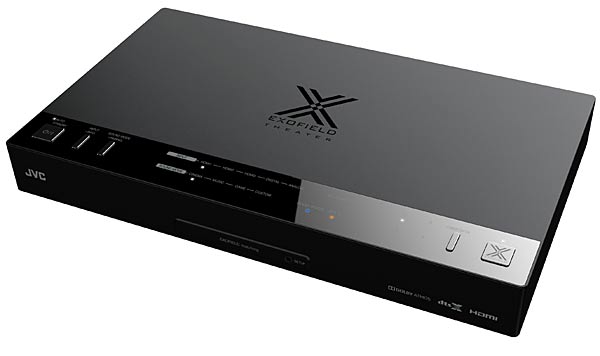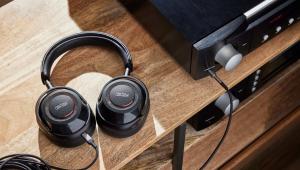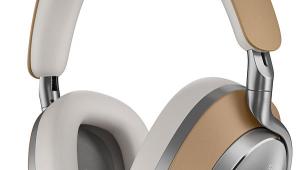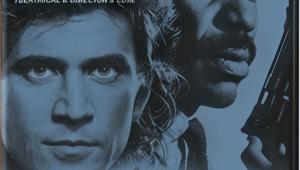JVC Exofield XP-EXT1 Personal Home Theater System Review

AT A GLANCE
Plus
Solid headphone-surround
Impressive Dolby Atmos, DTS:X effects
Long battery life
Minus
Substantial vocal tonality shifts
Uneven bass presentation
THE VERDICT
JVC’s Exofield XP-EXT1 delivers an impressive rendering of effects in immersive soundtracks, but it comes up short as an all- around wireless home theater headphones solution.
True surround sound from headphones has been an audio holy grail for decades, but with the ever-increasing power and value of digital signal processing, we're now getting closer to drinking from that particular chalice. JVC's latest effort is the XP-EXT1 Personal Home Theater System, a set of wireless over-the-ear cans with a slim processor/transmitter that uses the company's Exofield DSP processing to digitally rejigger surround-encoded soundtracks, including Dolby Atmos and DTS:X, for your in-head listening pleasure.
The business end is a set of large-but-comfortable wireless headphones that require the included processor/transmitter to work—you cannot pair them with your phone or other Bluetooth source. Their non- replaceable battery is charged via any USB power source; a cable is provided, though, oddly enough, no charging port is present on the transmitter/ processor. (JVC specifies battery life at 12 hours between charges, and in a series of much shorter sessions I believe I came close to that.)
The cans are fairly beefy—I measured 335 grams (for comparison, Sony's WH1000XM3 wireless noise-cancelling cans weigh about 255 grams)—and nicely finished, if a bit plasticky for a kilobuck. Of course, you're paying for a lot more here than just 'phones.

Which brings us to the processor/transmitter: a slim mini-component barely 0.75 inches tall, with a quartet of tiny pushbuttons on its top edge, two rows of pinpoint LEDs with nearly illegible labeling (they show selected input and mode) and an array of connections around back. These include: 3 HDMI inputs and an HDMI output with eARC, an optical digital input, an analog RCA stereo input, plus a tiny jack for the component's supplied cord-lump power supply. The HDMI connections do not support Dolby Vision HDR pass-through. An iOS/Android app is required for both setup and use but, a bit surprisingly, there's no Bluetooth-input capability to wirelessly send audio from your smartphone or tablet even though the app communicates control data with the system via Bluetooth. (Audio data travels from the processor to the head- phones via a dedicated 2.4/5.0 GHz link.)
Setup
After I had downloaded JVC's app to my iPhone 6s, I followed its prompts (and those in the supplied quick setup guide) to hardwire the headphones to the processor via the supplied sub-mini cable. The next step was to run a quick series of click-and-sweep test signals with the 'phones on my head to calibrate their performance to my individual head-and-ear characteristics. You can store a total of four such "runs" to accommodate the heads of other household members.
While the calibration routine proceeded as expected, with the process completed and the hardwire to the 'phones disconnected, I couldn't get anything to play out of the JVC cans. I then tried the analog input, which dutifully played stereo audio from my iPad jacked into the transmitter/processor via a 3.5mm-inch cable. Take a deep breath—easy.
I powered everything down, stripped all the wires, and started over with the simplest- possible layout: cable box and Blu-ray player's HDMI outputs connected to the processor's HDMI-1 and -2 inputs, and the processor's HDMI eARC output connected directly to my TV, bypassing my A/V preamp-processor altogether. Success! I then transferred the JVC processor's HDMI output to an HDMI input on my A/V pre-pro, connected the pre-pro's monitor-output to the TV, and everything worked exactly as it should: headphone sound when the JVC system was powered up, and sound from A/V sources passed-through to my amp/speaker setup when it was not.
Performance
With audio now happening, a quick cable channel scan turned up a Harry Potter film (Goblet of Fire) with Dolby Digital 5.1 sound. No question about it, the JVC headphones setup did a dramatic rendering of surround. Envelopment was pronounced, and lateral panning effects travelled distinctly, though front-to- back placement seemed more challenging. The front-to-back "stage" was compressed into a band stretching only modestly further forward, and rather less back, than the dimensions of my skull. Emphasis on "mine": like everything to do with headphones, individual results will vary, sometimes wildly, from head to head and pinna to pinna, so my impressions are just that—my impressions.


























































